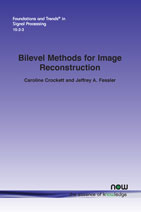Bilevel Methods for Image Reconstruction
By Caroline Crockett, University of Michigan, USA, cecroc@umich.edu | Jeffrey A. Fessler, University of Michigan, USA, fessler@umich.edu
Abstract
This review discusses methods for learning parameters for image reconstruction problems using bilevel formulations. Image reconstruction typically involves optimizing a cost function to recover a vector of unknown variables that agrees with collected measurements and prior assumptions. Stateof- the-art image reconstruction methods learn these prior assumptions from training data using various machine learning techniques, such as bilevel methods.
One can view the bilevel problem as formalizing hyperparameter optimization, as bridging machine learning and cost function based optimization methods, or as a method to learn variables best suited to a specific task. More formally, bilevel problems attempt to minimize an upper-level loss function, where variables in the upper-level loss function are themselves minimizers of a lower-level cost function.
This review contains a running example problem of learning tuning parameters and the coefficients for sparsifying filters used in a regularizer. Such filters generalize the popular total variation regularization method, and learned filters are closely related to convolutional neural networks approaches that are rapidly gaining in popularity. Here, the lower-level problem is to reconstruct an image using a regularizer with learned sparsifying filters; the corresponding upper-level optimization problem involves a measure of reconstructed image quality based on training data.
This review discusses multiple perspectives to motivate the use of bilevel methods and to make them more easily accessible to different audiences. We then turn to ways to optimize the bilevel problem, providing pros and cons of the variety of proposed approaches. Finally we overview bilevel applications in image reconstruction.
Bilevel Methods for Image Reconstruction
Methods for image recovery and reconstruction aim to estimate a good-quality image from noisy, incomplete, or indirect measurements. Such methods are also known as computational imaging. New methods for image reconstruction attempt to lower complexity, decrease data requirements, or improve image quality for a given input data quality.
Image reconstruction typically involves optimizing a cost function to recover a vector of unknown variables that agrees with collected measurements and prior assumptions. State-of-the-art image reconstruction methods learn these prior assumptions from training data using various machine learning techniques, such as bilevel methods. This review discusses methods for learning parameters for image reconstruction problems using bilevel formulations, and it lies at the intersection of a specific machine learning method, bilevel, and a specific application, filter learning for image reconstruction.
The review discusses multiple perspectives to motivate the use of bilevel methods and to make them more easily accessible to different audiences. Various ways to optimize the bilevel problem are covered, providing pros and cons of the variety of proposed approaches. Finally, an overview of bilevel applications in image reconstruction is provided.
